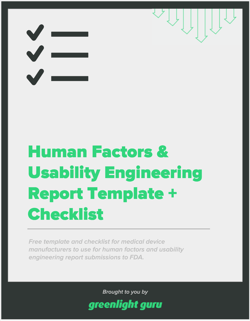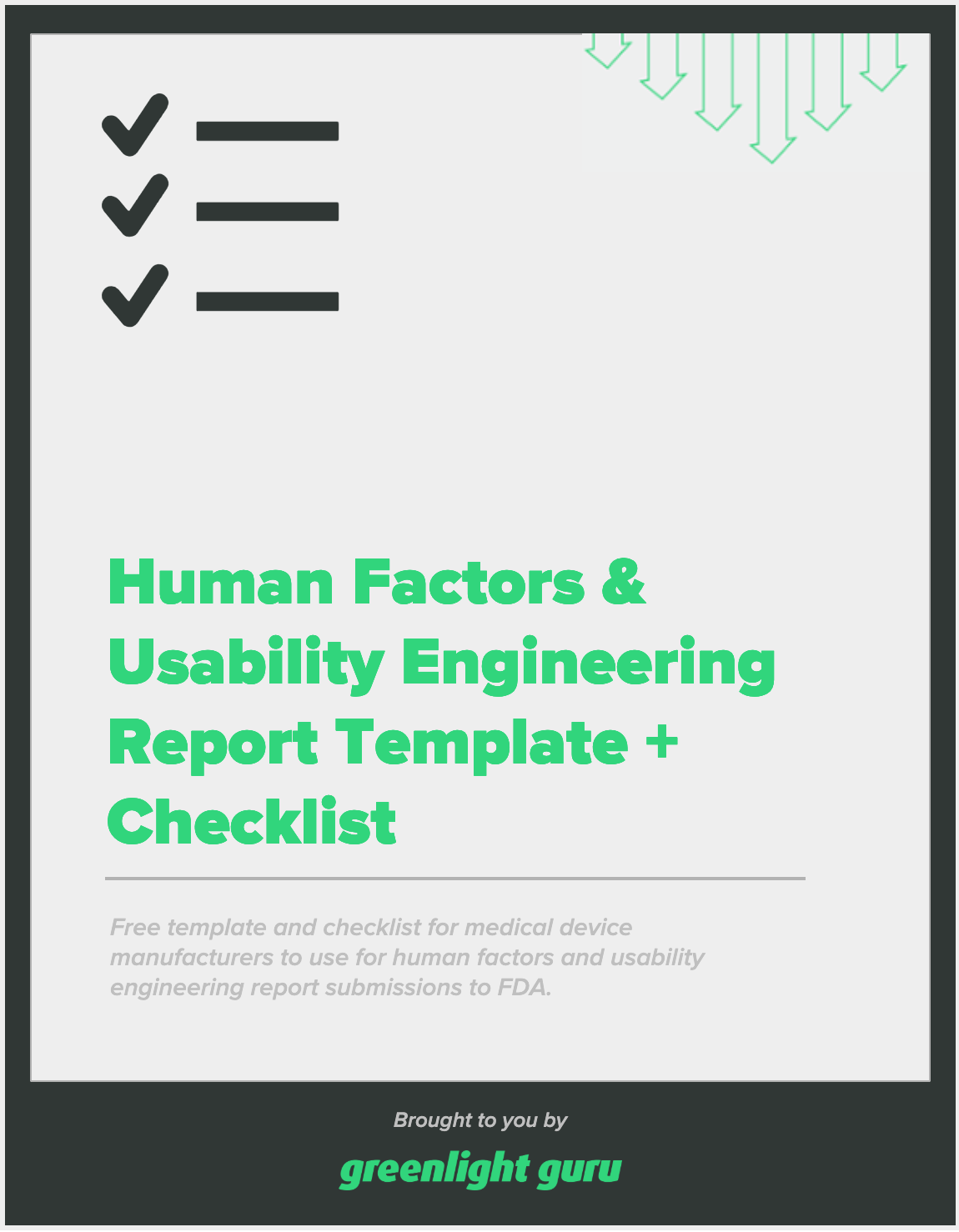FDA Human Factors Guidance Draft: What Medical Device Manufacturers Need to Know

On December 9, 2022, the FDA issued a new draft guidance,Content of Human Factors Information in Medical Device Marketing Submissions, which provides recommendations for the inclusion of human factors information in marketing submissions.
The drafted guidance is intended to supplement the FDA’s final guidance on Human Factors Evaluation (HFE). Once approved, the draft will replace the existing 2016 guidance.
To help you stay up-to-date we’ve dug deep into the new proposed guidance to give you everything you need to know on the FDA human factors guidance draft and what it could mean for your business.
FDA human factors guidance call for risk-based approach to gathering HFE information
One overarching theme in the new draft guidance is the agency’s proposal for a risk-based approach to human factors engineering information in marketing submissions.
“The goal of the human factors assessment is to ensure that the device user interface has been designed such that use errors that occur during use of the device that could cause harm or degrade medical treatment are either eliminated or reduced to the extent possible,” the FDA said in the guidance draft.
However, while human factors are of great importance, the FDA acknowledges that they are just one component of the agency’s assessments of marketing submissions. “While FDA believes that it is optimal to minimize use-related risks,” they said, “it may not be necessary, nor practical, to eliminate all use-related device risks.”
The agency calls this risk-based approach the HF Submission Category, and recommends that, at a high level, marketing submissions should serve the following purposes:
-
Demonstrate needs of the intended users were considered in the device design
-
Use risk-based analysis to determine categorization
-
Prove the device is safe and effective for the intended users, uses, and use environments
-
Provide information that explains the presence or absence of critical tasks
-
Show validation testing for risk mitigation strategies
-
Describe any residual risks
New marketing submission categories proposed in FDA human factors draft
In order to align with its recommendation for a risk-based approach, the FDA draft proposes three new categories based on the device’s indications for use and the use-related risk analysis.
-
Category 1 is intended for modifications on an existing device, with no changes to the user interface, intended users, uses, or use environments, training, or labeling.
-
Category 2 is intended for new devices that do not have any critical tasks or modifications made to an existing device (including changes to the user interface, intended users, uses, or use environments, training, or labeling) that do not add or impact critical tasks.
-
Category 3 is intended for new devices with critical tasks or modifications to an existing device (including changes to the user interface, intended users, uses, or use environments, training, or labeling) that add or impact critical tasks
As a way of guiding medical device manufacturers in determining the correct HF Submission Category, the FDA provides a flowchart, as well as accompanying tables and explanatory text.
In the HF Submission Category flowchart, we see three decision points that are accompanied by qualifying questions:
-
Is it a modification to an existing device?
-
Is there a change to any of the following?:
-
-
User interface
-
Intended device users
-
Intended device uses
-
Intended use environment(s)
-
Training
-
Labeling
-
3. Based on the use-related risk analysis, are there
-
-
(New devices only) Critical tasks?
-
(Modified devices only) New critical tasks introduced or are existing critical tasks impacted?
-
After arriving at the correct HF Submission Category, manufacturers can now turn to the final section detailing the required contents of their marketing submission and Human Factors Evaluation Reports.
FDA has new and updated guidelines for human factors evaluation reports
According to the draft guidance, human factors evaluation reports would include as many as eight sections:
-
Conclusion and high-level summary
-
Descriptions of intended device users, uses, use environments, and training
-
Description of device-user interface
-
Summary of known use problems
-
Summary of preliminary analyses and evaluations
-
Analysis of hazards and risks associated with use of the device
-
Identification and description of critical tasks
-
Details of the human factors validation testing of the final design
Depending on which category a device falls under, the human factors draft guidance establishes which points would need to be included in a human factors evaluation report.
Category 1 devices only need to include Section 1; Category 2 devices would need to include sections 1-4; and Category 3 devices require all 8 sections in the HRE report.
Lastly, the draft guidance outlines the content requirements for each section of the human factors evaluation report. These sections were previously established in the 2016 guidance, and not all sections have changed in the new draft guidance.
With that in mind, here are the key changes for each section in the new FDA human factors guidance draft:
-
Section 1: Conclusion and high-level summary. Should now include a high-level summary of the use-related risks, as well as a summary and analysis of the HFE process you’ve used.
-
Section 2: Descriptions of intended users, uses, use environments, and training. This section expands its examples of operational context of use, including aspects related to training, the device’s clinical applications, setup, maintenance, cleaning, and reprocessing.
-
Section 3: Description of device-user interface. If a device is modified, the FDA suggests utilizing a table to compare proposed and existing devices. You’ll also find a new sample table template.
-
Section 4: Summary of known use problems. No updates or changes.
-
Section 5: Summary of preliminary analyses and evaluations. No updates or changes.
-
Section 6: Analysis of hazards and risks associated with the use of the device. For modified devices in Category 3, manufacturers should submit an analysis comparing the modified device’s URRA to the existing device’s URRA.
-
Section 7: Identification and description of critical tasks. For submission Category 3, manufacturers would need to generate a table highlighting any new critical tasks and rationale for why the new tasks do not warrant new HF validation testing.
-
Section 8: Details of the human factors validation testing of the final design. No updates or changes.
Stay a step ahead of FDA’s human factors guidance with Greenlight Guru
Human factors engineering is essential for bringing a high-quality medical device to market because, in the end, it’s about providing the best quality management solution for patients under actual conditions of use.
Greenlight Guru is the only QMS software with the latest FDA regulations for MedTech built into every feature of the platform.
Over 1000 Greenlight Guru customers are already using our software to eliminate friction and bring together the right insights and capabilities to maintain human factors documentation in compliance with the latest regulatory best practices, all connected in an end-to-end solution that unites your teams.
Ready to learn more? Contact us today for your free demo of Greenlight Guru →
Etienne Nichols is the Head of Industry Insights & Education at Greenlight Guru. As a Mechanical Engineer and Medical Device Guru, he specializes in simplifying complex ideas, teaching system integration, and connecting industry leaders. While hosting the Global Medical Device Podcast, Etienne has led over 200...
Related Posts
Notification of a Manufacturing Discontinuance or Interruption: Does the FDA’s Guidance Apply to You?
Ultimate Guide to UDI for Medical Devices
FDA's Predetermined Change Control Plan: What's in the New Draft Guidance
Get your free PDF
Human Factors & Usability Engineering Report Template + Checklist










